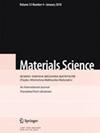Mechanical Properties of Recycled Concrete with Polypropylene Fiber and Its Bonding Performance with Rebars
IF 0.7
4区 材料科学
Q4 MATERIALS SCIENCE, MULTIDISCIPLINARY
引用次数: 0
Abstract
This paper explores the influence of polypropylene fiber on the mechanical properties of recycled concrete and the bonding performance between recycled concrete and steel bars. The results indicate that the compressive strength and splitting tensile strength of concrete decrease with the increase in the replacement rate of recycled aggregate. When the replacement rate of recycled aggregate was 100 %, the compressive strength of concrete decreased by 25.0%, while the splitting tensile strength of concrete decreased by 21.7 %. The compressive strength and splitting tensile strength of recycled aggregate concrete show a trend of first increasing and then decreasing with increasing fiber content. When the fiber content is 0.09 %, the compressive strength and tensile strength of recycled aggregate concrete are optimal. The bond strength of recycled concrete pullout specimens with fiber is higher than that of recycled concrete pullout specimens without fiber, while the slip of recycled concrete pullout specimens with fiber is lower than that of recycled concrete pullout specimens without fiber. The maximum improvement in bonding performance between recycled concrete and rebars with a 50 % recycled aggregate replacement rate is 13.7 %, and the maximum improvement in bonding performance between recycled concrete and rebars with a 100 % recycled aggregate replacement rate is 11.8 %. The bond strength shows a trend of first increasing and then decreasing with increasing fiber content, but the degree of decrease was not significant, while the slip shows a trend of first decreasing and then increasing with increasing fiber content. Compared to the compressive strength of concrete, the splitting tensile strength can better reflect the bond strength between concrete and rebar. The nonlinear relationship between the bond strength, compressive strength, and splitting tensile strength of recycled concrete is established. This study can effectively improve the mechanical properties of recycled concrete, expand the application scope of recycled concrete technology, and promote the sustainable development of the construction industry.含聚丙烯纤维的再生混凝土的力学性能及其与钢筋的粘结性能
本文探讨了聚丙烯纤维对再生混凝土力学性能以及再生混凝土与钢筋粘结性能的影响。结果表明,混凝土的抗压强度和劈裂拉伸强度随着再生骨料替代率的增加而降低。当再生骨料替代率为 100%时,混凝土的抗压强度降低了 25.0%,而劈裂抗拉强度降低了 21.7%。随着纤维含量的增加,再生骨料混凝土的抗压强度和劈裂抗拉强度呈现先增大后减小的趋势。当纤维含量为 0.09 % 时,再生骨料混凝土的抗压强度和抗拉强度达到最佳状态。含纤维的再生混凝土拔出试件的粘结强度高于不含纤维的再生混凝土拔出试件,而含纤维的再生混凝土拔出试件的滑移则低于不含纤维的再生混凝土拔出试件。再生骨料替代率为 50% 的再生混凝土与钢筋的粘结性能最大提高了 13.7%,再生骨料替代率为 100% 的再生混凝土与钢筋的粘结性能最大提高了 11.8%。随着纤维含量的增加,粘结强度呈先增后减的趋势,但减小的程度并不明显;而随着纤维含量的增加,滑移率呈先减后增的趋势。与混凝土抗压强度相比,劈裂抗拉强度更能反映混凝土与钢筋之间的粘结强度。建立了再生混凝土的粘结强度、抗压强度和劈裂抗拉强度之间的非线性关系。该研究可有效改善再生混凝土的力学性能,扩大再生混凝土技术的应用范围,促进建筑行业的可持续发展。
本文章由计算机程序翻译,如有差异,请以英文原文为准。
求助全文
约1分钟内获得全文
求助全文
来源期刊

Materials Science
工程技术-材料科学:综合
CiteScore
1.60
自引率
44.40%
发文量
63
审稿时长
4-8 weeks
期刊介绍:
Materials Science reports on current research into such problems as cracking, fatigue and fracture, especially in active environments as well as corrosion and anticorrosion protection of structural metallic and polymer materials, and the development of new materials.
 求助内容:
求助内容: 应助结果提醒方式:
应助结果提醒方式:


